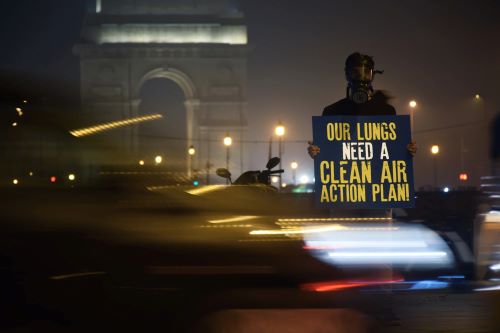Context-
When the Indian government launched the National Clean Air Programme (NCAP) in 2019, it was to cut the concentration of atmospheric Particulate Matter (PM) by 20-30% by 2024, from 2017 levels. This was later revised to 40% by 2026.
Most cities proactively submitted their CAAPs yet their implementation has been inconsistent. On average, only 60% of the allocated funds have been used thus far, according to the Ministry.
Inconsistent Implementation of Clean Air Action Plans (CAAPs)
Cities across India have demonstrated proactive engagement by submitting their Clean Air Action Plans (CAAPs) under the National Clean Air Programme (NCAP). However, the journey towards implementing these plans has been marred by inconsistency. The Ministry of Environment, Forest, and Climate Change allocated a substantial amount of ₹10,422.73 crore towards NCAP initiatives, yet the utilization of these funds remains suboptimal. On average, only 60% of the allocated funds have been spent, with some cities like Visakhapatnam and Bengaluru spending as little as 0% and 1%, respectively.
Challenges in Implementation:
● Bureaucratic Delays: One of the primary impediments to effective implementation is the sluggish approval processes from competent authorities. Delays in technical specifications for tendering processes and procurement of essential equipment such as mechanical sweepers and electric buses contribute significantly to project delays.
● Lack of Standard Operating Procedures: The absence of well-defined timelines and standard operating procedures further complicates the implementation process. This leads to ambiguity in the execution of control measures outlined in the CAAPs.
● Doubts Regarding Mitigation Measures: Lingering doubts about the efficacy of proposed mitigation measures, exacerbated by recent findings on the inefficacy of outdoor smog towers, have also hindered swift implementation.
Importance of Scientific Tools in Air Quality Management
The success of NCAP and effective implementation of CAAPs heavily rely on scientific tools that enable a comprehensive understanding of pollution sources and dispersion patterns. These tools not only aid in identifying the origins of pollution but also inform targeted pollution control strategies.
Role of Emissions Inventory (EI) and Source Apportionment (SA):
● Insights into Local Pollution Sources: Emissions Inventory studies provide critical insights into local pollution sources and their contributions. This allows experts to forecast future emissions based on various factors such as demographic shifts and technological advancements.
● Detailed Analysis through Source Apportionment: SA studies offer a detailed analysis of contributions from various pollution sources, including those located far away. However, they require substantial resources and specialized personnel for accurate chemical analysis.
● Limitations and Gaps: One of the challenges faced by EI and SA studies is their limitation in assessing the impact of transboundary pollution sources, such as stubble burning outside urban areas, on city air quality.
Role of Air Quality (AQ) Modelling:
● Understanding Pollution Dispersion: AQ modelling plays a crucial role in understanding pollution dispersion patterns, including contributions from distant sources. It informs decision-making processes for targeted interventions.
Challenges in Data Availability and Utilization
Despite the critical role of scientific tools, there are significant challenges in data availability and utilization across Indian cities participating in NCAP.
Data Gap and its Implications:
● Incomplete EI and SA Studies: A significant percentage (63%) of cities under NCAP have not completed EI and SA studies. This data gap impedes cities' abilities to effectively identify and target polluting activities.
● Effectiveness of CAAPs: The effectiveness of CAAPs is questioned when cities lack clarity on individual emission reduction potentials of proposed mitigation measures due to incomplete data.
Key Requirements for NCAP Success
Achieving the objectives outlined in NCAP requires a multifaceted approach that addresses challenges at various levels, from data acquisition to swift implementation.
Strategies for Success:
● Streamlined Implementation Processes: Implementation agencies must streamline processes to reduce bureaucratic red tape. Utilizing shared, standardized technical evaluations can expedite project approvals and execution.
● Technical Feasibility and Budgeting: Ensuring technical feasibility assessments, accurate budgeting, and realistic time estimates at the planning stage is critical for successful implementation.
● Need for Comprehensive Strategies: Existing control measures often focus solely on primary particulate matter (PM) emissions, neglecting secondary pollutants. A shift towards comprehensive strategies that address both primary and secondary pollutants is imperative.
Conclusion
The National Clean Air Programme (NCAP) presents a critical initiative towards improving air quality in India. However, its success hinges on overcoming challenges related to inconsistent implementation, data gaps, and bureaucratic hurdles. By leveraging scientific tools effectively and streamlining implementation processes, Indian cities can work towards achieving cleaner air and sustainable environmental outcomes outlined in the NCAP.
|
Probable Questions for UPSC Mains Exam- 1. What are the primary reasons behind the inconsistent utilization of allocated funds under the National Clean Air Programme (NCAP) by cities in India, and how can these challenges be addressed to ensure more effective implementation of Clean Air Action Plans (CAAPs)? ( 10 Marks, 150 Words) 2. How do scientific tools such as Emissions Inventory (EI) and Source Apportionment (SA) contribute to understanding pollution sources and developing targeted pollution control strategies under the NCAP, and what are the key obstacles preventing widespread adoption of these tools across Indian cities? ( 15 Marks, 250 Words) |
Source- The Hindu







